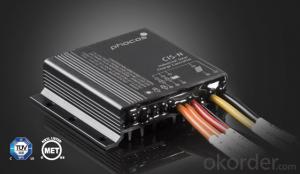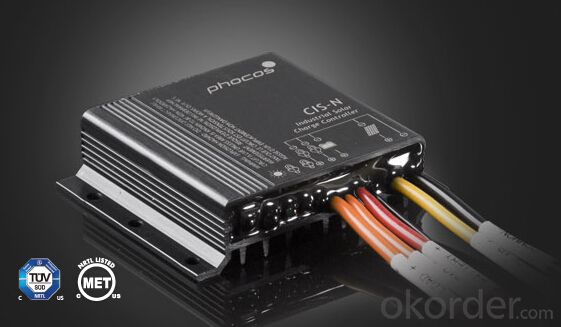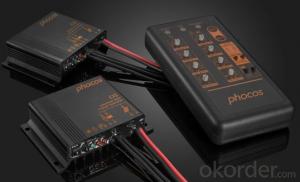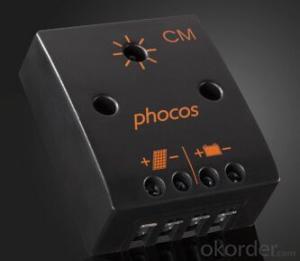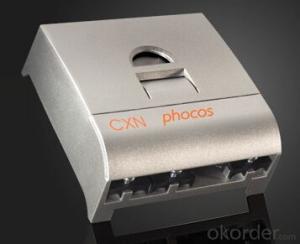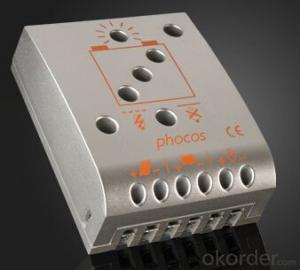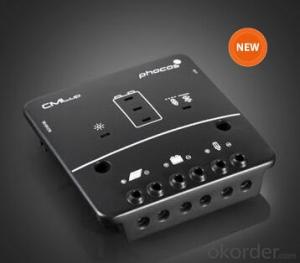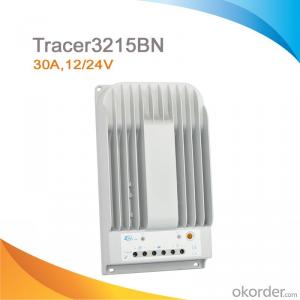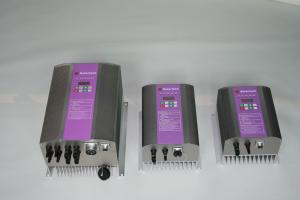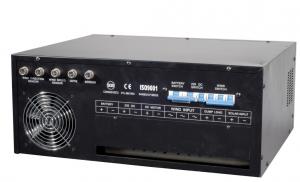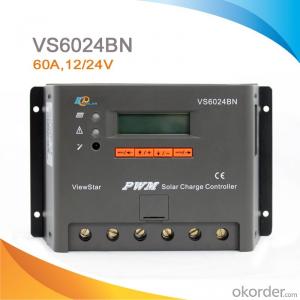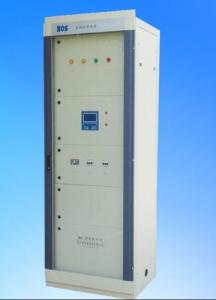Solar Charging Controllers - CIS-N Series (5 – 20 A) Solar Charge Controller
- Loading Port:
- China Main Port
- Payment Terms:
- TT OR LC
- Min Order Qty:
- -
- Supply Capability:
- 10000 unit/month
OKorder Service Pledge
OKorder Financial Service
You Might Also Like
· For applications in demanding and harsh environments (e.g. oil and gas industry)
· Negative grounding
· Robust aluminum housing
· Epoxy encapsulated PCB to prevent corrosion (IP68)
· Infrared remote control programming accessory (CIS-CU)
· Timer functions
· Wide range of programmable functions
· External temperature sensor (optional)
· 4-stage battery charging (main, float, boost, equalization)
· Dual load or dimmable load output
· Automatic system voltage recognition (12/24 V)
· Compact size
The Phocos CIS-N Charge Controller is one of the latest members of the successful Phocos family of fully encapsulated, high-performance CIS charge controllers providing optimum performance. Thanks to its high protection class (IP68), the CIS-N is ideal for applications in demanding environments such as the gas and oil industry (e.g. remote monitoring, weather stations, valves controlling, SCADA, and many more). It is also perfect for any solar outdoor applications which are exposed to harsh weather conditions. CIS-N was specially developed as a charge controller for applications requiring negative grounding, and features the identical properties as the popular positive-grounded CIS.
· It is available in two versions: A single load version with dimming output and a dual load version with two load outputs for independent control of two loads.
· The timer and other useful functions are completely programmable via the CIS-CU remote control unit. The small size of the devices offers extra flexibility, fitting easily into almost every application.
- Q: Can a solar controller be used in a solar-powered electric car racing system?
- Yes, a solar controller can be used in a solar-powered electric car racing system. A solar controller is responsible for regulating and optimizing the charging process of the batteries using solar panels. In a solar-powered electric car racing system, the solar controller would ensure efficient charging of the car's batteries, maximizing the utilization of solar energy and enhancing the overall performance of the vehicle.
- Q: How does a solar controller handle load control and diversion charging?
- Load control and diversion charging are managed by a solar controller, which utilizes its built-in features and capabilities. To control the load, the controller offers multiple load terminals or outputs that can be connected to various electrical loads. This allows the controller to regulate the power flow and manage the energy consumption of each load, preventing system overload and ensuring efficient use of solar power. On the other hand, diversion charging involves redirecting surplus energy generated by the solar panels to charge additional devices or batteries. This is achieved by connecting a diversion load, such as a dump load or secondary battery bank, to the solar controller. When the connected loads require less energy than what is being produced, the excess power is diverted to the diversion load, preventing overcharging of batteries and maximizing solar energy utilization. Sophisticated algorithms and monitoring systems are commonly employed by solar controllers to determine when to activate load control or diversion charging. These algorithms take factors like battery voltage, solar panel output, and load requirements into consideration to make intelligent decisions regarding power distribution and diversion. Some controllers even utilize advanced MPPT technology to optimize solar panel output and ensure efficient power conversion. In conclusion, a solar controller effectively manages load control and diversion charging by providing multiple load terminals for power distribution and redirecting excess energy to a diversion load. It utilizes algorithms and monitoring systems to make intelligent decisions and optimize the utilization of solar energy.
- Q: Can a solar controller be used with solar panel ground screws?
- Yes, a solar controller can be used with solar panel ground screws. A solar controller is responsible for regulating the amount of electricity flowing from the solar panels to the batteries. The use of ground screws to secure the solar panels does not affect the compatibility or functionality of the solar controller.
- Q: What is the maximum charging current that a solar controller can provide?
- The maximum charging current that a solar controller can provide depends on several factors including the specifications of the solar controller itself and the capacity of the battery being charged. Solar controllers typically have a maximum charging current rating, which is the maximum amount of current that it can safely provide to the battery. This rating can vary widely depending on the model and brand of the solar controller. Additionally, the maximum charging current that a solar controller can provide might also be limited by the capacity of the battery being charged. Some batteries have specific charging requirements and limitations, and exceeding these limitations can lead to damage or reduced battery lifespan. It is important to consult the specifications and guidelines of both the solar controller and the battery to determine the maximum charging current that can be safely utilized.
- Q: How does a solar controller handle battery reverse polarity protection?
- A solar controller handles battery reverse polarity protection by incorporating circuitry that detects and prevents the flow of current in the event of reversed battery connections. This protection mechanism ensures that the controller and the battery are not damaged due to incorrect polarity, safeguarding the system from potential harm.
- Q: Can a solar controller be used with solar-powered indoor entertainment systems?
- Solar-powered indoor entertainment systems can indeed utilize a solar controller. This crucial component of a solar power system plays a vital role in regulating and managing the flow of electricity from the solar panels to the connected devices. Although indoor systems may not demand the same power as their outdoor counterparts, employing a solar controller optimizes energy usage and safeguards against overcharging or device damage. Additionally, the solar controller offers valuable insights such as battery status and energy production, enabling users to monitor and optimize their energy consumption. In summary, integrating a solar controller into a solar-powered indoor entertainment system guarantees efficient and dependable performance while harnessing the advantages of renewable energy.
- Q: How does a solar controller handle the protection against battery reverse discharge?
- A solar controller handles the protection against battery reverse discharge by monitoring the voltage of the battery. If the voltage drops below a certain threshold, indicating that the battery is being discharged in the wrong direction, the controller will automatically disconnect the battery from the solar panels to prevent any further discharge. This helps to protect the battery from damage and ensures its longevity.
- Q: How do I prevent undercharging of batteries with a solar controller?
- To avoid undercharging batteries when using a solar controller, there are several important measures you should take: 1. Choose the appropriate solar controller: It is crucial to select a solar charge controller that is specifically designed for your battery type. Different batteries have different charging requirements, and using an incompatible controller can lead to undercharging or overcharging. 2. Determine the correct size for your solar array: Ensure that the wattage of your solar panels is sufficient to fulfill the energy needs of your battery system. If the solar array is too small, it may not generate enough power to fully charge the batteries, resulting in undercharging. 3. Establish the proper charging parameters: Most solar charge controllers allow for adjustments to voltage set points and charging algorithms. Consult the manufacturer's instructions or user manual to identify the optimal settings for your battery type, and configure the controller accordingly. 4. Monitor battery voltage and state of charge: Regularly check the battery voltage and state of charge using a battery monitor or voltmeter. This will enable you to assess whether the batteries are being adequately charged. Consistently low voltage or lack of expected increases in state of charge may indicate undercharging. 5. Consider temperature compensation: Some solar controllers offer temperature compensation features, which adapt the charging parameters based on the ambient temperature. This can help prevent undercharging in extreme hot or cold conditions, as temperature can impact battery charging efficiency. 6. Regularly maintain and clean your solar panels: Keep your solar panels clean and free from debris to maximize their efficiency. Dust, dirt, or shading can diminish the amount of power generated, potentially leading to undercharging. By following these guidelines, you can significantly minimize the risk of undercharging your batteries with a solar controller, ensuring they receive the necessary charge for optimal performance and longevity.
- Q: Can a solar controller be used with a solar-powered healthcare facility?
- Yes, a solar controller can be used with a solar-powered healthcare facility. A solar controller is an essential component of a solar power system as it regulates the charging and discharging of batteries, ensuring optimal performance and protection. In a solar-powered healthcare facility, the solar controller will effectively manage the energy generated by the solar panels, storing it in batteries for use during periods of low sunlight or increased demand. This ensures a consistent and reliable power supply, supporting the healthcare facility's operations and providing uninterrupted healthcare services.
- Q: Can a solar controller be used with different types of solar panel monitoring systems?
- Yes, a solar controller can be used with different types of solar panel monitoring systems. A solar controller is responsible for regulating and optimizing the charging process of solar panels to prevent overcharging or undercharging of batteries. It does not directly interact with the monitoring system, which is used to measure and display the performance and output of the solar panels. As long as the solar controller is compatible with the specific solar panel and battery setup, it can be used in conjunction with any type of monitoring system. The monitoring system will continue to function independently, providing real-time data on the solar panel's performance, while the solar controller ensures efficient charging and battery management.
Send your message to us
Solar Charging Controllers - CIS-N Series (5 – 20 A) Solar Charge Controller
- Loading Port:
- China Main Port
- Payment Terms:
- TT OR LC
- Min Order Qty:
- -
- Supply Capability:
- 10000 unit/month
OKorder Service Pledge
OKorder Financial Service
Similar products
Hot products
Hot Searches
Related keywords
